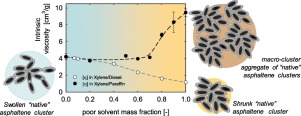当前位置:
X-MOL 学术
›
Fuel Process. Technol.
›
论文详情
Our official English website, www.x-mol.net, welcomes your
feedback! (Note: you will need to create a separate account there.)
Effect of solvents on the microstructure aggregation of a heavy crude oil
Fuel Processing Technology ( IF 7.2 ) Pub Date : 2018-08-01 , DOI: 10.1016/j.fuproc.2018.05.016 Mario Minale , Maria C. Merola , Claudia Carotenuto
Fuel Processing Technology ( IF 7.2 ) Pub Date : 2018-08-01 , DOI: 10.1016/j.fuproc.2018.05.016 Mario Minale , Maria C. Merola , Claudia Carotenuto

|
Abstract We study the asphaltene microstructure in a heavy crude oil in response to the addition of solvents of different qualities by measuring the intrinsic viscosity and the Huggins coefficient. Dilution with good solvents (xylene and cyclohexanone) causes the native asphaltene clusters swelling, while that with poor solvents (a diesel oil and a C11-C14 alkanes mixture) may induce different microstructural rearrangements. The mixture of C11-C14 alkanes induces the aggregation of clusters, while the diesel oil their shrinkage. Moreover, if the diesel is added in small quantities instead of cluster shrinkage it may induce cluster aggregation thus forming larger “macro-clusters”. These structures survive after further dilution in both poor and good solvents and their formation is always accompanied by a reduction of the Huggins coefficient that implies the better solubility of these self-aggregated structures in the used solvent. Finally, an unusual negative Huggins coefficient is measured, when the macro-clusters are formed and the solution is diluted in a good solvent. This might be due to a prevalence of the intra-macro-cluster interactions on the inter-macro-cluster ones.
中文翻译:

溶剂对稠油微观结构聚集的影响
摘要 我们通过测量特性粘度和哈金斯系数来研究重质原油中沥青质微观结构对添加不同质量溶剂的反应。用良溶剂(二甲苯和环己酮)稀释会导致天然沥青质簇膨胀,而用不良溶剂(柴油和 C11-C14 烷烃混合物)稀释可能会引起不同的微观结构重排。C11-C14 烷烃的混合物引起簇的聚集,而柴油则引起它们的收缩。此外,如果少量添加柴油而不是集群收缩,它可能会导致集群聚集,从而形成更大的“宏观集群”。这些结构在不良溶剂和良好溶剂中进一步稀释后仍然存在,并且它们的形成总是伴随着哈金斯系数的降低,这意味着这些自聚集结构在所用溶剂中的溶解性更好。最后,当大团簇形成并且溶液在良溶剂中稀释时,测量到一个不寻常的负哈金斯系数。这可能是由于宏群间相互作用的宏群内相互作用的普遍存在。
更新日期:2018-08-01
中文翻译:

溶剂对稠油微观结构聚集的影响
摘要 我们通过测量特性粘度和哈金斯系数来研究重质原油中沥青质微观结构对添加不同质量溶剂的反应。用良溶剂(二甲苯和环己酮)稀释会导致天然沥青质簇膨胀,而用不良溶剂(柴油和 C11-C14 烷烃混合物)稀释可能会引起不同的微观结构重排。C11-C14 烷烃的混合物引起簇的聚集,而柴油则引起它们的收缩。此外,如果少量添加柴油而不是集群收缩,它可能会导致集群聚集,从而形成更大的“宏观集群”。这些结构在不良溶剂和良好溶剂中进一步稀释后仍然存在,并且它们的形成总是伴随着哈金斯系数的降低,这意味着这些自聚集结构在所用溶剂中的溶解性更好。最后,当大团簇形成并且溶液在良溶剂中稀释时,测量到一个不寻常的负哈金斯系数。这可能是由于宏群间相互作用的宏群内相互作用的普遍存在。











































 京公网安备 11010802027423号
京公网安备 11010802027423号